Yoga Sadhana Class 4 Notes Physical Education Chapter 7 Free PDF
What is Yoga Sadhana?
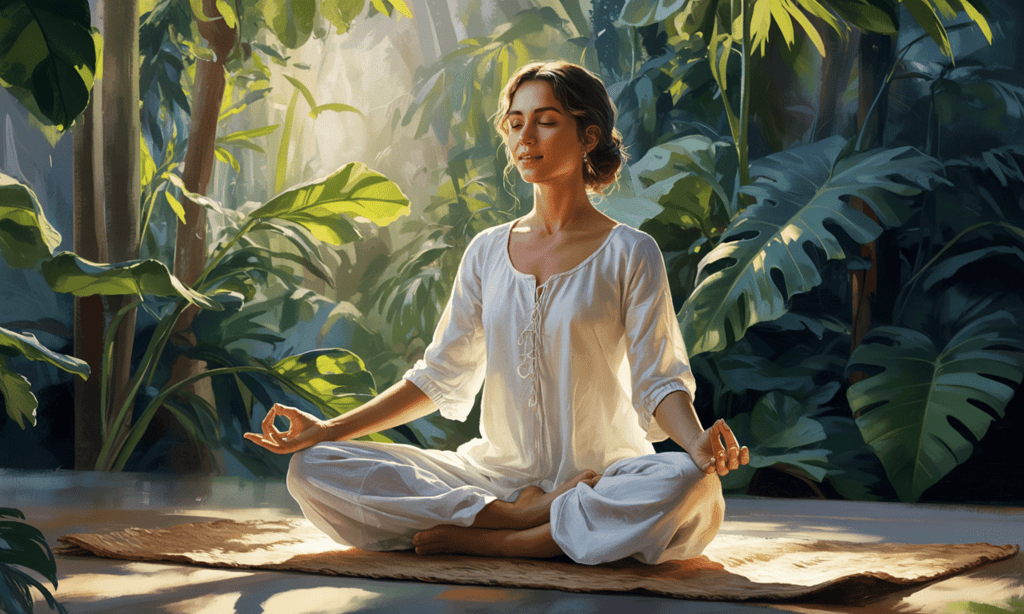 Mindfulness
Mindfulness
Yoga Sadhana is about practicing yoga regularly and with dedication.
- It means more than just doing exercises; it's about living with discipline, focus, caring for others, and being aware of oneself.
- In this chapter, students will learn how to weave yoga into their everyday lives and how it can improve their body, mind, and behavior.
- Yoga Sadhana builds inner strength, peace, and a healthy way of living.
Preparatory Practices
Just like how singers warm up their voices before performing, preparatory exercises help loosen our joints and prepare our bodies for yoga postures (asanas).
These exercises increase flexibility and strength for better performance during yoga practice. Below are a few preparatory practices:
Camel Walk
Stand on all fours with hips raised, forming an inverted "V".
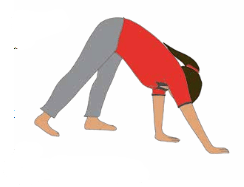 Camel Walk
Camel Walk
Move your right hand and left leg forward, then move your left hand and right leg forward.
Keep your knees straight and avoid bending them. Continue walking for a few minutes.
Toe Walk
Stand with legs together, interlock your fingers, and raise your hands above your head.
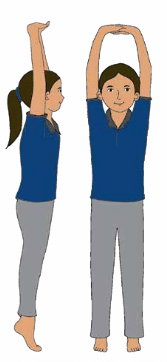 Toe Walk
Toe WalkStart walking on your toes, moving forward and backward.
Crab Walk
Sit on your buttocks with hands behind you and knees bent, feet flat on the ground.
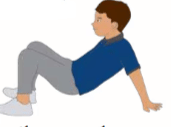 Crab Walk
Crab WalkLift your buttocks off the ground while keeping your hands and feet on the floor.
Walk forwards or backwards using hands and feet while maintaining balance.
Anguli Shakti Vikaasaka (Finger Strengthening)
Stand with a slight gap between your legs.
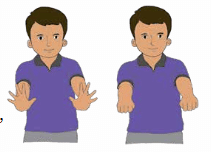 Finger Strengthening
Finger StrengtheningStretch your arms forward. Inhale and spread your fingers wide, then exhale and compress your fingers together.
Manibandh Shakti Vikaasaka (Wrist Strengthening)
Stand with a little gap between your legs and stretch both arms forward.
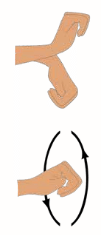 Wrist Strengthening
Wrist StrengtheningMake fists and move wrists up while inhaling and down while exhaling. Repeat five times.
Rotate wrists clockwise and anticlockwise five times each.
Kaponi Shakti Vikaasaka (Elbow Strengthening)
Stand with a slight gap between your legs and raise arms parallel to the ground.
While inhaling, bend elbows, and while exhaling, stretch arms forward.
Bhuja Bandha Shakti Vikaasaka (Shoulder Strengthening)
Stand with legs apart and place palms on your shoulders, forming a cup shape.
Rotate shoulders clockwise and anticlockwise for five times each.
Hand Stretch Practices
These stretching practices help coordinate breathing with movements and are divided into horizontal, oblique, and vertical stretches.
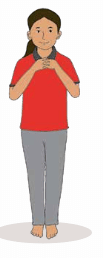 Hand Stretch Practices
Hand Stretch Practices
Horizontal Stretch
Stand straight, interlock fingers in front of your chest.
Inhale, stretch your arms horizontally with palms facing outward.
Exhale and bring your arms back in front of your chest. Repeat five times.
Oblique Stretch
Stand straight, interlock fingers in front of your chest.
Inhale, stretch your arms diagonally (obliquely), then exhale and return to the chest. Repeat five times.
Vertical Stretch
Stand straight, interlock fingers in front of your chest.
Inhale, stretch your arms vertically above your head with palms facing upward.
Exhale and bring your hands back to your chest. Repeat five times.
Asanas
Asanas are body postures practiced to keep the body strong, flexible, and healthy. They require two qualities: stability and comfort.
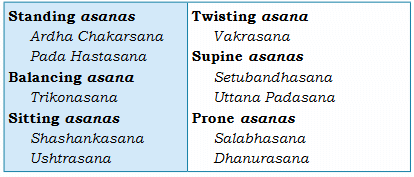 Types of Asanas
Types of Asanas
1. Ardha Chakrasana (Half Wheel Pose)
Meaning: "Ardha" means "half" and "Chakra" means "wheel." In this pose, the body resembles a half-wheel when bent backward.
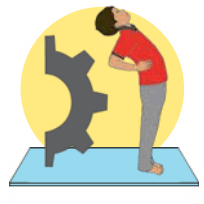
Steps:
Stand with your feet apart, about hip-width distance.
Place your hands on your lower back with fingers pointing forward and elbows parallel to each other.
Inhale deeply and bend backward from your waist, supporting your back with your palms. Ensure your body forms a half-wheel shape.
Hold the posture and breathe normally. Focus on your breath while keeping the legs straight.
Slowly straighten your back while exhaling and release the hands back to the starting position.
2. Pada Hastasana (Hands to Feet Pose)
Meaning: "Pada" means "foot," and "Hasta" means "hand." This asana involves bending forward to touch the feet with hands.
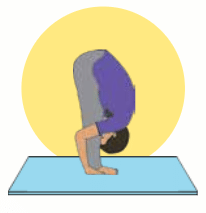
Steps:
Stand with your feet about 2 feet apart.
Inhale, raise both arms above the head, and stretch upward.
Exhale and bend forward from the waist, keeping the knees straight. Try to keep your back straight as you lower your torso.
Place your palms on the floor next to your feet, and try to touch your forehead to your knees.
Hold the position, breathing deeply, and aim to relax into the stretch.
Inhale to raise your arms and head, then slowly come back to standing with a straight back.
3. Trikonasana (Triangle Pose)
Meaning: "Tri" means "three," and "Kona" means "angle." This asana forms three angles in the body, resembling a triangle.
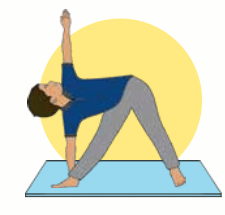
Steps:
Stand with feet spread 2 to 3 feet apart.
Stretch both arms sideways, palms facing down.
Inhale, and while exhaling, bend your body to the right side, touching your right foot with the right hand. Extend your left arm upwards toward the ceiling.
Look up at your left hand while maintaining the stretch.
Hold the position and breathe deeply.
To release, inhale and bring the hands back to parallel to the ground, straightening your legs.
Repeat the same on the left side.
4. Shashankasana (Rabbit Pose)
Meaning: "Shashanka" means "rabbit," and the posture resembles a rabbit's rounded back or the crescent moon shape.
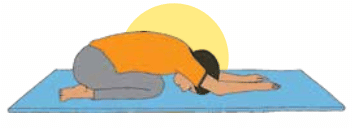
Steps:
Sit in Dandasana (Staff Pose) and then come to Vajrasana (Thunderbolt Pose).
Inhale, raise both arms above the head.
Exhale, and bend forward, placing your forehead and palms on the ground. Your chest should rest on your thighs, and your heels should touch your buttocks.
Hold the position, maintaining normal breathing.
Inhale slowly, come back up to a seated position, and lower the arms to the sides.
5. Ushtrasana (Camel Pose)
Meaning: "Ushtra" means "camel." The final posture resembles the back of a camel.
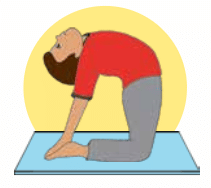
Steps:
Sit in Dandasana (Staff Pose) and then come to Vajrasana (Thunderbolt Pose).
Kneel and place your hands on your hips.
Inhale and bend backward slightly (Ardha Ushtrasana).
If possible, place both hands on your heels, pushing your hips forward so your thighs are vertical to the floor.
Hold the posture with normal breathing.
To release, inhale, straighten the back, and return to Vajrasana.
6. Vakrasana (Twisted Pose)
Meaning: "Vakra" means "twist." This asana involves twisting the upper body to one side.
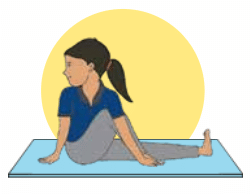
Steps:
Sit in Dandasana (Staff Pose).
Inhale and bend the right leg, placing the foot beside the left knee.
Exhale and twist the body to the right, holding the right foot with the left hand, and place the right hand behind you for support.
Hold the posture and breathe deeply.
To release, inhale and return to the center, then repeat on the left side.
7. Setubandhasana (Bridge Pose)
Meaning: "Setu" means "bridge" and "Bandha" means "formation." This asana forms a bridge-like structure with the body.
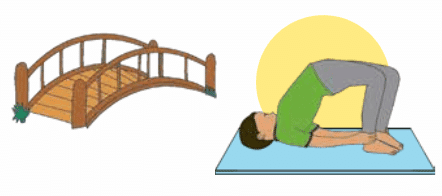
Steps:
Lie on your back with knees bent and heels close to the buttocks.
Inhale, lift the hips off the floor, and keep your thighs parallel to the ground. The chin should touch the chest.
Hold the posture for a few seconds while breathing normally.
Exhale slowly and lower the hips, releasing the hands and legs.
8. Uttanapadasana (Raised Leg Pose)
Meaning: "Uttana" means "raised" and "Padas" means "legs." In this asana, the legs are raised above the ground.
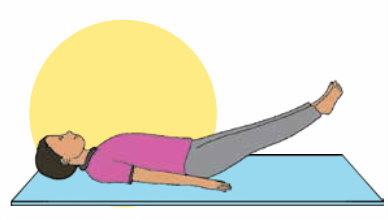
Steps:
Lie on your back with arms by your sides.
Inhale and raise both legs straight up, about 1.5 to 2 feet above the ground, keeping the knees straight.
Hold the position for a few seconds while breathing normally.
Exhale and slowly lower the legs back to the floor.
9. Shalabhasana (Locust Pose)
Meaning: "Shalabha" means "locust." The final posture resembles a locust's body.
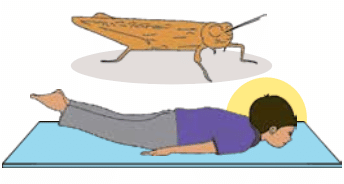
Steps:
Lie on your abdomen with legs together and arms at your sides.
Place your hands under your thighs with palms facing downward.
Inhale and raise both legs up while keeping the knees straight.
Hold the position for a few seconds while breathing normally.
Exhale and slowly lower the legs and release the hands.
10. Saral Dhanurasana (Simple Bow Pose)
Meaning: "Dhanu" means "bow." The final posture resembles the shape of a bow.
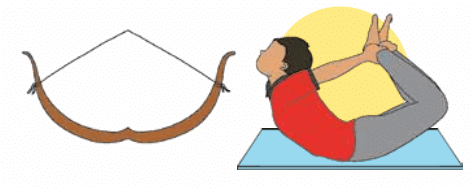
Steps:
Lie on your abdomen with legs together and arms by your sides.
Bend your knees and bring the heels toward your buttocks, holding the ankles with both hands.
Inhale, lift your chest off the ground, and pull the legs upward.
Hold the position for a few seconds with normal breathing.
Exhale and slowly lower your legs and chest back to the floor, releasing your hands.
Common Guidelines for Asana Practice
Practice on an empty stomach.
Perform asanas on a yoga mat or clean, non-slippery surface.
Move slowly to avoid injuries.
Perform complementary asanas after completing the practice of each asana.
Inform the teacher if feeling uncomfortable or unwell.
Children with medical conditions should inform the teacher before practicing yoga.
Relaxation Technique: Shavasana
Shavasana is practiced at the end of the yoga session to relax the body and mind.

Lie on your back with hands and legs apart.
Close your eyes and relax.
Focus on slow, deep breaths, and the movement of the abdomen.
Stay in this posture for 5 minutes, then slowly sit up.
Pranayama (Breathing Exercises)
Pranayama is a set of controlled breathing exercises designed to regulate the flow of prana (life energy) through the body. It helps calm the mind, improve concentration, and enhance overall health.
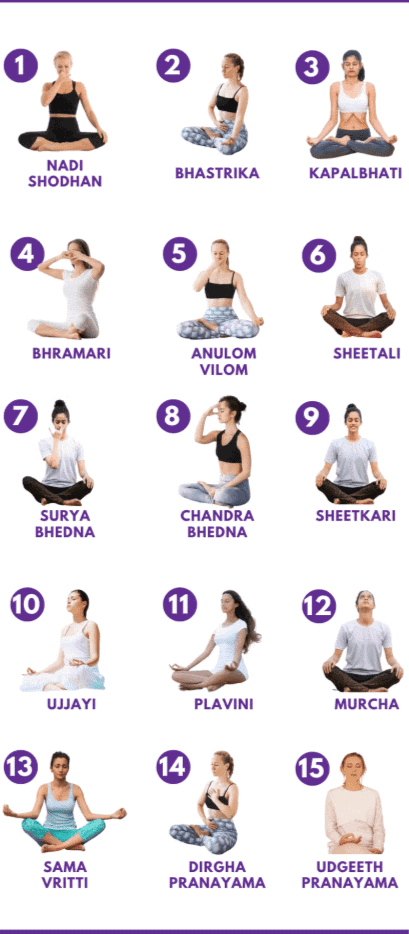 Pranayams
Pranayams
1. Deep Breathing
Steps:
Sit comfortably in a relaxed posture such as Sukhasana (Easy Pose) or Padmasana (Lotus Pose).
Close your eyes and focus on your breath.
Inhale deeply through the nose, expanding your lungs fully. As you inhale, notice how the chest and abdomen rise.
Exhale slowly through the nose, allowing the chest and abdomen to fall as you release the air.
Continue this process for a few minutes, focusing on the rise and fall of your chest and abdomen with each breath.
Benefits:
Reduces stress and anxiety.
Promotes relaxation and mental clarity.
Improves lung capacity and respiratory function.
2. Om Chanting
Steps:
Sit in a comfortable, upright position with your spine straight and eyes closed.
Inhale deeply through the nose, filling your lungs with air.
As you exhale, chant the sound "AUM" (pronounced as "Om") slowly and steadily, allowing the sound to resonate throughout your body.
Feel the vibrations of the sound within your body as you chant.
Repeat this process for several rounds, focusing on the vibration and energy created by the sound.
Benefits:
Calms the mind and enhances focus.
Balances the body’s energy and stimulates the throat chakra.
Helps to relieve stress and improve mental well-being.
3. Anuloma Viloma Pranayama (Alternate Nostril Breathing)
Steps:
Sit in a comfortable position with your back straight and shoulders relaxed.
Using your right hand, close the right nostril with your thumb.
Inhale slowly and deeply through the left nostril.
Close the left nostril with your ring finger, then open the right nostril and exhale slowly through the right.
Now, inhale through the right nostril, close the right nostril again, and exhale through the left nostril.
This completes one round. Continue for 5-10 rounds, focusing on your breath and the alternate nostril flow.
Benefits:
Balances the flow of energy in the body.
Calms the nervous system and relieves stress.
Improves concentration and mental clarity.
Enhances lung capacity and clears nasal passages.
4. Brahmari Pranayama (Bee Sound Breathing)
Steps:
Sit comfortably with your spine straight and eyes closed.
Gently close your ears by pressing the tragi (the small part of the ear near the ear canal) with your index fingers.
Inhale deeply through the nose, filling your lungs with air.
As you exhale, make a humming sound, similar to that of a bee (the sound “MMMM”).
Feel the vibrations created by the sound, especially around your head and face.
Repeat the process for 5-10 rounds, keeping your breath steady and the humming sound consistent.
Benefits:
Reduces stress and promotes relaxation.
Improves concentration and mental clarity.
Calms the mind and soothes the nervous system.
Relieves tension in the head and face.
Kriyas (Internal Cleansing Techniques)
Kriyas are yogic practices aimed at cleaning the body from the inside, promoting physical and mental well-being. These techniques help purify the body and remove toxins, enhancing overall health.
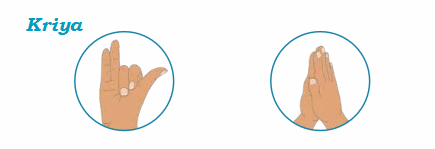
1. Karnarandra Dhauti (Ear Cleansing)
Steps:
Use your index or ring finger with neatly trimmed nails.
Wet your finger with water and gently insert it into the ear canal.
Move the finger in a circular motion inside the ear to clean the ear canal and remove any dirt or wax.
Repeat this process for both ears.
Benefits:
Improves hearing ability by removing earwax.
Maintains ear hygiene and reduces the risk of ear infections.
Enhances the function of the auditory system.
2. Kapalarandra Dhauti (Head Cleansing)
Steps:
Wet your palms with water.
Gently cup your palms and place them on the top of your head.
Bend forward slightly and gently pat the middle portion of your head with your wet palms three to four times.
Ensure that the palms are moistened and the head is gently tapped to cleanse the upper part of the head.
Benefits:
Relieves mental fatigue and tiredness.
Energizes the body and sharpens focus.
Improves circulation and stimulates the scalp, promoting healthy hair growth.
Krida Yoga (Yoga Games)
Krida Yoga focuses on enhancing attention, concentration, and mindfulness through playful activities. These games are designed to help students reduce distractions, develop focus, and build mental clarity in a fun and engaging way.
1. Lakshyam (Dot Focus Game)
Purpose: To develop concentration and focus.
How to Play:
Pair up the students.
One student holds a paper with a dot marked on it at chin level.
The other student stands 5 feet away and focuses on the dot, trying not to be distracted.
The student holding the paper makes funny faces to try and distract the other student.
The student who maintains focus on the dot without laughing for the longest time wins the round.
After one minute, the students switch roles, and the game continues.
Benefits:
Improves concentration and attention span.
Develops the ability to focus in the presence of distractions.
Enhances mental control and discipline.
2. Kanduka Tadanam (Ball Bouncing Game)
Purpose: To improve focus, coordination, and team play.
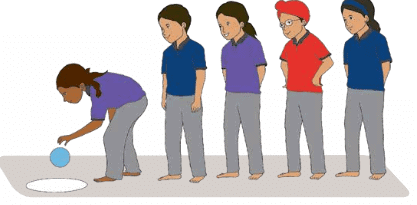
Materials Required: A basketball and chalk.
How to Play:
Form teams of five students each.
Draw a large circle on the ground, about five times the size of a basketball.
Each student takes turns bouncing a basketball inside the circle for one minute.
If the ball bounces out of the circle, the student is out of the game.
The student who keeps the ball inside the circle for the longest time wins.
Benefits:
Develops hand-eye coordination and motor skills.
Improves concentration and focus during physical activity.
Encourages teamwork and group participation.
FAQs on Yoga Sadhana Class 4 Notes Physical Education Chapter 7 Free PDF
| 1. What is Yoga Sadhana and how does it differ from regular yoga practice? |  |
| 2. What are the benefits of practicing Yoga Sadhana for students in Class 4? |  |
| 3. How can parents support their children in practicing Yoga Sadhana at home? |  |
| 4. What specific techniques should be included in a Yoga Sadhana routine for Class 4 students? |  |
| 5. How often should children in Class 4 engage in Yoga Sadhana practices? |  |





















